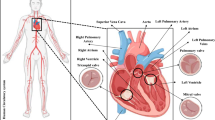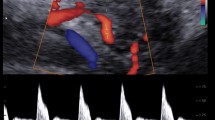Abstract
The most significant anatomical structure of the umbilical cord is its level of coiling. The coiled geometry of the umbilical cord largely affects umbilical blood flow that is vital for fetus’s well-being and normal development. In this study, we developed a computational model of steady blood flow through the coiled structure of an umbilical artery. The results showed that the driving pressure for a given blood flow rate is increasing as the number of coils in cord structure increases. The driving gradient pressures also vary with the pitch that dictates the coils’ spreading. The coiled structure is resulting in interwoven streamlines along the helix and wall shear stresses (WSS) with significant spatial gradients along the cross-sectional perimeter anywhere within the helical coil. These gradients may have an adverse effect on the development of the fetus cardiovascular system in cases with over coiling (OC) or under coiling (UC) characteristics. The number of coils does not affect the distribution and levels of WSS. However, when the coils are more spread (eg, larger pitch number), the maximal WSS is significantly smaller. Cases with twisted and OC cords seem to yield very large values and gradients of WSS, which may place the fetus into high risk of abnormal development.
Similar content being viewed by others
References
de Laat MW, Franx A, van Alderen ED, Nikkels PG, Visser GH. The umbilical coiling index, a review of the literature. J Matern Fetal Neonatal Med. 2005;17(2):93–100.
Strong TH Jr, Jarles DL, Vega JS, Feldman DB. The umbilical coiling index. Am J Obstet Gynecol. 1994;170(1 pt 1):29–32.
Machin GA, Ackerman J, Gilbert-Barness E. Abnormal umbilical coiling is associated with adverse perinatal outcomes. Pediatr Dev Pathol. 2000;3(5):462–471.
de Laat MW, van Alderen ED, Franx A, Visser GH, Bots ML, Nikkels PG. The umbilical coiling index in complicated pregnancies. Eur J Obstet Gynecol Reprod Biol. 2007;130(1):66–72.
Degani S, Lewinsky RM, Berger H, Spiegel D. Sonographic estimation of umbilical coiling index and correlation with Doppler flow characteristics. Obstet Gynecol. 1995;86(6): 990–993.
Peng HQ, Levitin-Smith M, Rochelson B, Kahn E. Umbilical cord stricture and overcoiling are common causes of fetal demise. Pediatr Dev Pathol. 2006;9(1):14–19.
Berger SA, Talbot L, Yao LS. Flow in curved pipes. Ann Rev Fluid Mech. 1983;15:461–512.
Ali S. Pressure drop correlations for flow through regular helical coil tubes. Fluid Dyn Res. 2001;28(4):295–310.
Yamamoto K, Alam MM, Yasuhara J, Aribowo A. Flow through a rotating helical pipe with circular cross-section. Int J Heat Fluid Flow. 2000;21(2):213–220.
Kliener-Assaf A, Jaffa AJ, Elad D. Hemodynamic model for analysis of Doppler ultrasound indexes of umbilical blood flow. Am J Physiol. 1999;276(6 pt 2):H2204–H2214.
Gordon Z, Eytan O, Jaffa AJ, Elad D. Hemodynamic analysis of Hyrtl anastomosis in the human placenta. Am J Physiol Regul Integr Comp Physiol. 2007;292(2):R977–R982.
Sherer DM, Anyaegbunam A. Prenatal ultrasonographic morphologic assessment of the umbilical cord: a review. Part II. Obstet Gynecol Surv. 1997;52(8):515–523.
Kleinstreuer C. Biofluid Dynamics: Principles and Selected Applications. Boca Raton, FL: CRC Taylor & Francis; 2006.
Acharya G, Wilsgaard T, Rosvold-Berntsen GK, Maltau JM, Kiserud T. Reference ranges for umbilical vein blood flow in the second half of pregnancy based on longitudinal data. Prenat Diagn. 2005;25(2):99–111.
Kiserud T. Physiology of the fetal circulation. Semin Fetal Neonatal Med. 2005;10(6):493–503.
Kaplan C. Twist and shout: the excitement over coils in the umbilical cord. Pediatr Dev Pathol. 2006;9(1):1–2.
Sebire NJ. Pathophysiological significance of abnormal umbilical cord coiling index (opinion). Ultrasound Obstet Gynecol. 2007;30(6):804–806.
Germano M. The Dean equation extended to helical pipe flow. J Fluid Mech. 1989;203:289–305.
Cunningham KS, Gotlieb AI. The role of shear stress in the pathogenesis of atherosclerosis. Lab Invest. 2005;85(1):9–23.
Maalej N, Holden JE, Folts JD. Effect of shear stress on acute platelet thrombus formation in canine stenosed carotid arteries: an in vivo quantitative study. J Thrombosis Thrombolysis. 1998;5(3):231–238.
Poelmann RE, Gittenberger-de Groot AC, Hierck BP. The development of the heart and microcirculation: role of shear stress. Med Biol Eng Comput. 2008;46(5):479–484.
Hove JR, Koster RW, Forouhar AS, Acevedo-Bolton G, Fraser SE, Gharib M. Intracardiac fluid forces are an essential epigenetic factor for embryonic cardiogenesis. Nature. 2003; 421(6919):172–177.
Strong TH, Elliot JP, Radin TG. Non-coiled umbilical blood vessels: a new marker for the fetus at risk. Obstet Gynecol. 1993; 81(3):409–411.
Heifetz SA. Single umbilical artery. A statistical analysis of 237 autopsy cases and review of the literature. Perspect Pediatr Pathol. 1984;8(4):345–378.
Kaplan CG. Color Atlas of Gross Placental Pathology. 2nd ed. chap. 3. New York: Springer; 2007.
Helmlinger G, Geiger RV, Schreck S, Nerem RM. Effects of pulsatile flow on cultured vascular endothelial cell morphology. J Biomech Eng. 1991;113(2):123–131.
Malek AM, Alper SL, Izumo S. Hemodynamic shear stress and its role in atherosclerosis. JAMA. 1999;282(21):2035–2042.
Author information
Authors and Affiliations
Corresponding author
Rights and permissions
About this article
Cite this article
Kaplan, A.D., Jaffa, A.J., Timor, I.E. et al. Hemodynamic Analysis of Arterial Blood Flow in the Coiled Umbilical Cord. Reprod. Sci. 17, 258–268 (2010). https://doi.org/10.1177/1933719109351596
Published:
Issue Date:
DOI: https://doi.org/10.1177/1933719109351596




